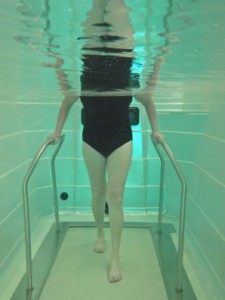Research compares the metabolic responses from land to underwater treadmill exercise
The University of Maine’s exercise science department along with professors from the Rutgers Equine Science Center developed and published the research study, “The metabolic response to treadmill graded exercise: traditional vs. underwater.” The purpose of the study was to the determine the metabolic effects of four graded exercise tests performed on an underwater treadmill and then compare them to the results from performing the standard Bruce protocol (see the table below) on a traditional land treadmill.
Bruce Protocol
| Stage | Minutes | % grade | MPH | METS |
|---|---|---|---|---|
| 1 | 3 | 10 | 1.7 | 4 |
| 2 | 3 | 12 | 2.5 | 7 |
| 3 | 3 | 14 | 3.4 | 10 |
| 4 | 3 | 16 | 4.2 | 11 |
| 5 | 3 | 18 | 5.0 | 13 |
| 6 | 3 | 20 | 5.5 | 15 |
| 7 | 3 | 22 | 6.0 | 15 |
Total Duration = 21 minutes
Twelve male Division 1 athletes from the University of Maine’s hockey team each performed the Bruce protocol and the four graded tests on the underwater treadmill. Additionally, the researchers collected data about their oxygen 
For an athletic trainer, and even a coach, there is always a concern when rehabilitating an athlete with a joint injury. Will they return at the same level as they were before they got injured? How will you maintain their cardiovascular conditioning during their rehab? How do you return them quickly, but safely? Some of these concerns were the motivation behind this research study. At the end of the study, Professor Robert Lehnhard stated, “This piece of equipment [underwater treadmill] fits nicely when joint impact is a concern.”
Lehnhard believes the underwater treadmill, with resistance jets, could also benefit non-athletes since many people, particularly those just beginning an exercise program, are not conditioned for repeated impact on their joints.
As a result of their study they found that the underwater treadmill graded protocol was comparable to the Bruce protocol on many levels. Additionally, for rehabilitation purposes that include a fitness maintenance component with low-impact, underwater treadmill therapy and exercises would be the better option.
Some of the benefits of underwater treadmill exercise include:
- Promotes early range of motion
- Initiates gait training in a low impact environment
- Improves cardiovascular stamina
- Increases flexibility
- Impacts muscle strengthening
Download our Research Studies Book for a comprehensive overview of studies that have been done on underwater treadmills.


